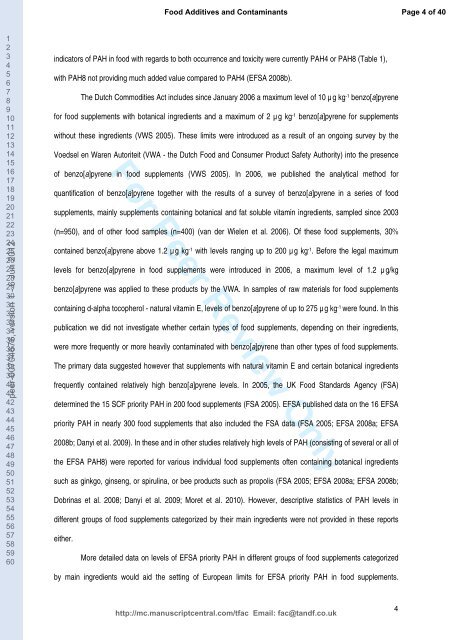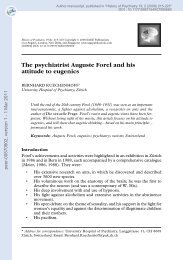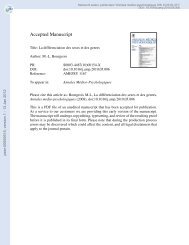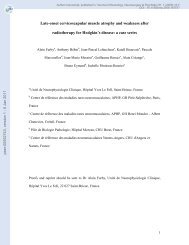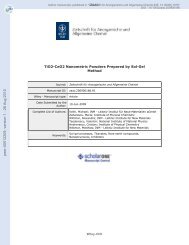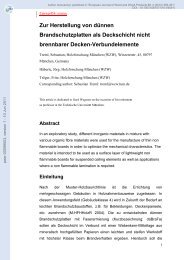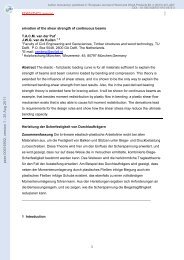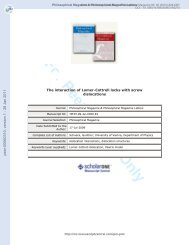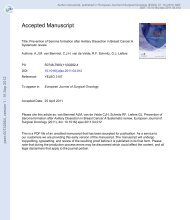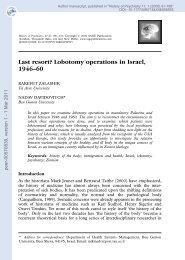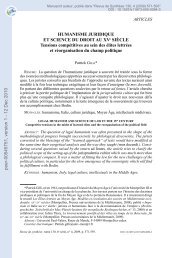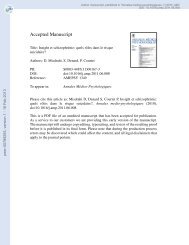Monitoring of Polycyclic Aromatic Hydrocarbons (PAH) in food ...
Monitoring of Polycyclic Aromatic Hydrocarbons (PAH) in food ...
Monitoring of Polycyclic Aromatic Hydrocarbons (PAH) in food ...
You also want an ePaper? Increase the reach of your titles
YUMPU automatically turns print PDFs into web optimized ePapers that Google loves.
1<br />
2<br />
3<br />
4<br />
5<br />
6<br />
7<br />
8<br />
9<br />
10<br />
11<br />
12<br />
13<br />
14<br />
15<br />
16<br />
17<br />
18<br />
19<br />
20<br />
21<br />
22<br />
23<br />
24<br />
25<br />
26<br />
27<br />
28<br />
29<br />
30<br />
31<br />
32<br />
33<br />
34<br />
35<br />
36<br />
37<br />
38<br />
39<br />
40<br />
peer-00704676, version 1 - 6 Jun 2012<br />
41<br />
42<br />
43<br />
44<br />
45<br />
46<br />
47<br />
48<br />
49<br />
50<br />
51<br />
52<br />
53<br />
54<br />
55<br />
56<br />
57<br />
58<br />
59<br />
60<br />
<strong>in</strong>dicators <strong>of</strong> <strong>PAH</strong> <strong>in</strong> <strong>food</strong> with regards to both occurrence and toxicity were currently <strong>PAH</strong>4 or <strong>PAH</strong>8 (Table 1),<br />
with <strong>PAH</strong>8 not provid<strong>in</strong>g much added value compared to <strong>PAH</strong>4 (EFSA 2008b).<br />
The Dutch Commodities Act <strong>in</strong>cludes s<strong>in</strong>ce January 2006 a maximum level <strong>of</strong> 10 µ g kg -1 benzo[a]pyrene<br />
for <strong>food</strong> supplements with botanical <strong>in</strong>gredients and a maximum <strong>of</strong> 2 µ g kg -1 benzo[a]pyrene for supplements<br />
without these <strong>in</strong>gredients (VWS 2005). These limits were <strong>in</strong>troduced as a result <strong>of</strong> an ongo<strong>in</strong>g survey by the<br />
Voedsel en Waren Autoriteit (VWA - the Dutch Food and Consumer Product Safety Authority) <strong>in</strong>to the presence<br />
For Peer Review Only<br />
<strong>of</strong> benzo[a]pyrene <strong>in</strong> <strong>food</strong> supplements (VWS 2005). In 2006, we published the analytical method for<br />
quantification <strong>of</strong> benzo[a]pyrene together with the results <strong>of</strong> a survey <strong>of</strong> benzo[a]pyrene <strong>in</strong> a series <strong>of</strong> <strong>food</strong><br />
supplements, ma<strong>in</strong>ly supplements conta<strong>in</strong><strong>in</strong>g botanical and fat soluble vitam<strong>in</strong> <strong>in</strong>gredients, sampled s<strong>in</strong>ce 2003<br />
(n=950), and <strong>of</strong> other <strong>food</strong> samples (n=400) (van der Wielen et al. 2006). Of these <strong>food</strong> supplements, 30%<br />
conta<strong>in</strong>ed benzo[a]pyrene above 1.2 µ g kg -1 with levels rang<strong>in</strong>g up to 200 µ g kg -1 . Before the legal maximum<br />
levels for benzo[a]pyrene <strong>in</strong> <strong>food</strong> supplements were <strong>in</strong>troduced <strong>in</strong> 2006, a maximum level <strong>of</strong> 1.2 µ g/kg<br />
benzo[a]pyrene was applied to these products by the VWA. In samples <strong>of</strong> raw materials for <strong>food</strong> supplements<br />
conta<strong>in</strong><strong>in</strong>g d-alpha tocopherol - natural vitam<strong>in</strong> E, levels <strong>of</strong> benzo[a]pyrene <strong>of</strong> up to 275 µ g kg -1 were found. In this<br />
publication we did not <strong>in</strong>vestigate whether certa<strong>in</strong> types <strong>of</strong> <strong>food</strong> supplements, depend<strong>in</strong>g on their <strong>in</strong>gredients,<br />
were more frequently or more heavily contam<strong>in</strong>ated with benzo[a]pyrene than other types <strong>of</strong> <strong>food</strong> supplements.<br />
The primary data suggested however that supplements with natural vitam<strong>in</strong> E and certa<strong>in</strong> botanical <strong>in</strong>gredients<br />
frequently conta<strong>in</strong>ed relatively high benzo[a]pyrene levels. In 2005, the UK Food Standards Agency (FSA)<br />
determ<strong>in</strong>ed the 15 SCF priority <strong>PAH</strong> <strong>in</strong> 200 <strong>food</strong> supplements (FSA 2005). EFSA published data on the 16 EFSA<br />
priority <strong>PAH</strong> <strong>in</strong> nearly 300 <strong>food</strong> supplements that also <strong>in</strong>cluded the FSA data (FSA 2005; EFSA 2008a; EFSA<br />
2008b; Danyi et al. 2009). In these and <strong>in</strong> other studies relatively high levels <strong>of</strong> <strong>PAH</strong> (consist<strong>in</strong>g <strong>of</strong> several or all <strong>of</strong><br />
the EFSA <strong>PAH</strong>8) were reported for various <strong>in</strong>dividual <strong>food</strong> supplements <strong>of</strong>ten conta<strong>in</strong><strong>in</strong>g botanical <strong>in</strong>gredients<br />
such as g<strong>in</strong>kgo, g<strong>in</strong>seng, or spirul<strong>in</strong>a, or bee products such as propolis (FSA 2005; EFSA 2008a; EFSA 2008b;<br />
Dobr<strong>in</strong>as et al. 2008; Danyi et al. 2009; Moret et al. 2010). However, descriptive statistics <strong>of</strong> <strong>PAH</strong> levels <strong>in</strong><br />
different groups <strong>of</strong> <strong>food</strong> supplements categorized by their ma<strong>in</strong> <strong>in</strong>gredients were not provided <strong>in</strong> these reports<br />
either.<br />
Food Additives and Contam<strong>in</strong>ants<br />
More detailed data on levels <strong>of</strong> EFSA priority <strong>PAH</strong> <strong>in</strong> different groups <strong>of</strong> <strong>food</strong> supplements categorized<br />
by ma<strong>in</strong> <strong>in</strong>gredients would aid the sett<strong>in</strong>g <strong>of</strong> European limits for EFSA priority <strong>PAH</strong> <strong>in</strong> <strong>food</strong> supplements.<br />
http://mc.manuscriptcentral.com/tfac Email: fac@tandf.co.uk<br />
4<br />
Page 4 <strong>of</strong> 40


